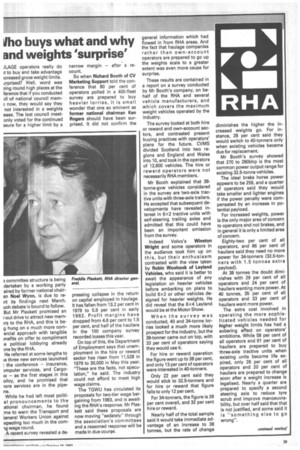Ilho buys what and why and weights 'surprise'
Page 21

If you've noticed an error in this article please click here to report it so we can fix it.
JLAGE operators really do it to buy and take advantage Icreased gross weight limits. urprised? Well, word was zing round high places at the ference that if you conducted )11 of national council mem
now, they would say they not interested in a weights ease. The last council meetonly voted for the continued ssure for a higher limit by a
a committee structure is being Idertaken by a working party aired by former national chairan Noel Wynn, is due to reort its findings next March. uch debate is bound to follow. But Mr Plaskett promised an I-out drive to attract new mem)rs to the RHA, and this is beg hung on a much more cornercial approach with tangible 3nefits on offer to compliment ,e political lobbying already 3ne by the RHA.
He referred at some lengths to le three new services launched t the conference — insurance, prnputer services, and Cargo ix as the first stages in this olicy, and he promised that lore services are in the pipene.
While he had left most politial pronouncements to the ational chairman, he found ime to warn the Transport and ;eneral Workers Union against xpecting too much in the cornig wage round.
A recent survey revealed a de narrow margin — after a recount.
So when Richard Booth of CV Marketing Support told the conference that 80 per cent of operators polled in a 400-fleet survey are prepared to buy heavier lorries, it is small wonder that one so eminent as former national chairman Ken Rogers should have been surprised. It did not confirm the
pressing collapse in the return on capital employed in haulage. It has fallen from 13.2 per cent in 1979 to 5.9 per cent in early 1982. Profit margins have dropped from 4.6 per cent to 1.5 per cent, and half of the hauliers in the 100 company survey recorded losses this year.
On top of this, the Department of Employment says that unemployment in the hire or reward sector has risen from 11,528 in 1979 to 30,000 in May this year. "These are the facts, not speculation," he said. The industry could not afford to meet high wage claims.
The TGWU has circulated its proposals for two-tier wage bargaining from 1983, and is awaiting the RHA's response. Mr Plaskett said these proposals are now moving "sedately" through the association's committees and a reasoned response will be made in due course. general information which had flowed in from RHA areas. And the fact that haulage companies rather than own-account operators are prepared to go up the weights scale to a greater extent was even more cause for surprise.
These results are contained in a report on a survey conducted by Mr Booth's company, on behalf of the RHA and several vehicle manufacturers, and which covers the maximum weight vehicles operated by the industry.
The survey looked at both hire or reward and own-account sectors, and contrasted present buying practices with operators' plans for the future. CVMS divided Scotland into two regions and England and Wales into 10, and took in the operators of 12,600 vehicles. The hire or reward operators were not necessarily RHA members.
Mr Booth explained that 38tonne-gvw vehicles considered in the survey are two-axle tractive units with three-axle trailers. He accepted that subsequent developments have revealed interest in 6x2 tractive units with self-steering trailing axles and admitted that this could have been an important omission from the survey.
Indeed Volvo's Winston Wright and some operators in the audience took him up on this, but their enthusiasm contrasted with the view taken by Robin Woolcock of Leyland Vehicles, who said it is better to await the appearance of any legislation on heavier vehicles before embarking on plans to build 6x2 or other vehicles designed for heavier weights. He did reveal that the 6x4 Leyland would be at the Motor Show.
When the survey was conducted, 40 and 34-tonne lorries looked a much more likely prospect for the industry, but the 38-tonner came out on top, with 33 per cent of operators saying they would use it.
For hire or reward operation the figure went up to 38 per cent, and only 13 per cent of operators were interested in 40-tonners.
Only 22 per cent said they would stick to 32.5-tonners and for hire or reward that figure falls to only 12 per cent.
For 34-tonners, the figure is 28 per cent overall, and 32 per cent hire or reward.
Nearly half of the total sample said it would take immediate advantage of an increase to 38 tonnes, but the rate of change




















































































